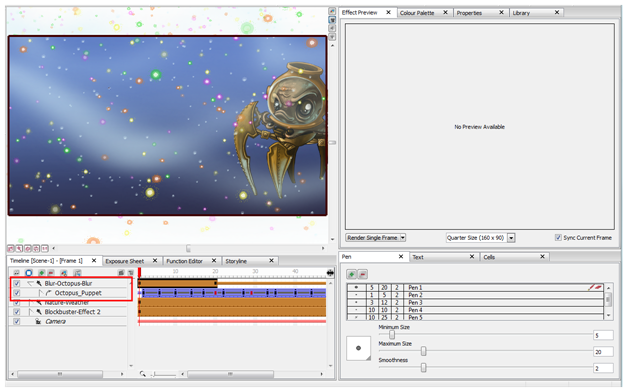
- #DOING CEL ANIMATION IN TOON BOOM STUDIO 8 MOVIE#
- #DOING CEL ANIMATION IN TOON BOOM STUDIO 8 SOFTWARE#
- #DOING CEL ANIMATION IN TOON BOOM STUDIO 8 SERIES#
Computer animation is now routine in television, movies and advertisement, and it's entirely possible to create in your own home. The advent of small, affordable personal computers was another major step that made this possible. Pixar's "Toy Story" (1995) was the first completely CGI full-length film.īoth ILM and Pixar, along with other emerging computer graphics houses, would develop lots of technical innovations for use in computer animation, some of which eventually filtered into commercially available software. It was while Catmull was there in 1986 that Steve Jobs purchased Lucasfilm's Computer Graphics Division and it became Pixar.
#DOING CEL ANIMATION IN TOON BOOM STUDIO 8 MOVIE#
It wasn't long before some of the top computer graphics talent started working in the film industry for outfits like George Lucas's movie special effects powerhouse, Industrial Light and Magic (ILM), originally created to do special effects work for "Star Wars." Jim Blinn and Ed Catmull both worked for Lucasfilm, though at different times.
#DOING CEL ANIMATION IN TOON BOOM STUDIO 8 SERIES#
First, he made realistic computer animations of the Voyager missions that aired on news programs starting in 1979, and then he and his team at the JPL contracted to do graphical renderings for Carl Sagan's 1980 PBS series "Cosmos." (Blinn would later develop "Blinn shading" and an enhancement to texture mapping called "bump mapping.") Not surprisingly, Catmull would go on to co-found Pixar.Ī one-time student of Ivan Sutherland named Jim Blinn did some of the earliest television CG work while working for NASA's Jet Propulsion Laboratory (JPL). It featured a moving wireframe hand and face, as well as those same models covered in smooth skin. The first 3-D rendered movie, a short called "A Computer Animated Hand," was created in 1972 by Ed Catmull and Fred Parke at the University of Utah. Zajac for Bell Labs around 1963 using the FORTRAN programming language. One early wireframe animation of a satellite orbiting a planet was created by Edward E. Most computer graphics for the next couple of decades were created by people with programming skills and access to expensive government, corporate or university mainframes.

#DOING CEL ANIMATION IN TOON BOOM STUDIO 8 SOFTWARE#
īut it would be a while before anyone was creating animations with user-friendly software applications. Although conceived for engineering applications, he noted in his dissertation that "it might be exciting to try making cartoons." He even drew a face with an animated winking eye as part of a demo. It was, in effect, the first interactive animation software. Sutherland used it to create a program called Sketchpad, which enabled the user create line drawings and make them move on a computer screen with a light pen and tablet. The TX series machines were some of the first computers to have monitors. The TX-2 was a giant multitasking mainframe created in the 1950s that was used for military applications, air traffic control, payroll and census processing, and various other tasks. student Ivan Sutherland gained temporary access to an old TX-2 computer. The computer-generated imagery (CGI) characters and objects we increasingly see in live-action movies are created by animators using software, too. Whether fanciful or realistic, animations routinely appear in a number of other places, including advertisements, websites, educational videos and video games, to name but a few. Some people still create traditional hand-drawn animation, but most of the cartoons we see today are created using computer software.


This created longer, more detailed cartoons than people had seen before, but it required creating a large number of images (usually around 24 per second of film). In the early 20th century, greats like Max Fleischer and Walt Disney created individual images on paper, animation cels or some other physical medium, photographed each one and then had a movie reel of the photographs developed.

Early devices like the zoetrope (a cylinder with images inside that appeared to be moving when spun) were created to view what amounted to very short cartoons, but the invention of photography, and then projectors, took animation to a whole new level. Viewing them in quick succession creates the illusion of motion. Making an animation requires producing a series of images that change gradually over the course of many frames. Cartoons are fun and entertaining to behold, but they're also a lot of work to create.


 0 kommentar(er)
0 kommentar(er)
